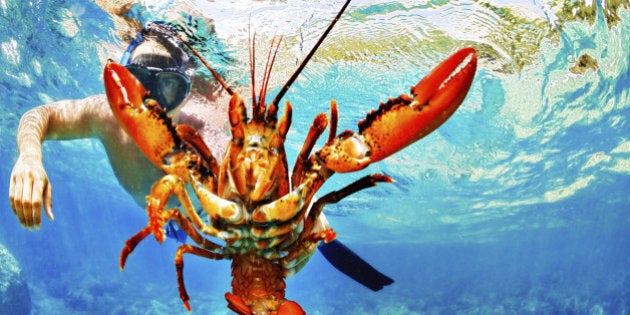
Lobsters and oysters are among Australian marine life that could begin literally dissolving as our oceans become increasingly acidic.
It may sound like a piece of speculative science fiction, but ocean acidification is a well-documented phenomena and the world's experts are currently meeting in Hobart for the 4th international Oceans in a High CO2 World symposium.
Ocean acidification occurs when the world's waters absorb carbon dioxide from the air, which lowers the entire ocean's pH level. If there is enough carbon dioxide in the air, it puts all marine animals at risk that rely on a carbonate exoskeleton.
Species with these exoskeletons like lobsters, crayfish, mussels and oysters will begin to dissolve and be less able to build their protective shells, creating thinner, slower growing shells that are more vulnerable to predators.
What's more, the same process can dissolve entire coral reefs, and new research released this week shows increasingly acidic waters on the Great Barrier Reef are already having an effect, with coral growing 7 percent slower than at the start of the industrial revolution.
The industrial revolution is a pertinent comparison point because ocean acidification is caused by increased carbon dioxide in the air, which is in turn caused by the burning of fossil fuels, which ramped up around the time fuel-burning machines became common.
Today, we're pumping more carbon dioxide into the air than ever before, and CSIRO oceans and atmosphere senior research scientist Andrew Lenton said there were precise measurements going back six decades on the way oceans respond.
"This is really the predictable and measurable consequence of rising carbon dioxide levels," Lenton said.
"What we can see is even low emissions, that is akin to the Cop 21 emissions [targets] to the end of the century, we’ll see an increase in ocean acidification and decrease in pH, meaning that even if we’re able to keep our emmissions to the level we’re hoping to, the changes are so large that corals, for example, will experience conditions where they’re not historically found."
In other words, corals have not been shown to survive in the level of pH scientists believe our oceans are headed.
"It doesn’t happen in isolation, it’s also warming at the same time so we’ve got to start thinking about understanding ocean acidification, with warming and other changes to determine how it will impact the marine system into the future."
Back to lobsters and oysters. US National Oceanic and Atmospheric Administration senior scientist Richard A Feely said the U.S. had a concerning window into a future where all the world's oceans were more acidic because of an anomalic ocean upwelling that brought carbon dioxide-rich water to the west coast of the U.S. between April and November each year.
"It's a very unique situation," Feely said.
"Those two combined increases in carbon dioxide causes pH drops in the order of the future that we might expect in the open oceans at the end of the century and the impact of that has been striking."
Feely said it decimated the oyster industry and dissolved the shells of some snails.
"We’ve seen large impact on our oyster industry beginning in 2006 and 2007 to the point that the shellfish in hatcheries, the oyster larvae were dying off within two days and they had no way to recover."
"What we did in that case, we taught the shellfish growers how to raise the pH inside hatcheries and allow them to grow normally. We developed an adaptation strategy that worked and the question is, can we do the same thing in the open ocean?"
The strategy the farmers employed was planting kelp and seagrass that naturally lowered the pH in the surrounding water when they photosynthesize.
University of Tasmania’s Institute for Marine and Antarctic Studies marine biologist Catriona Hurd said planting seaweed worked on a small scale, in cold-water systems, but we needed a global response to change the entire ocean's pH levels and avoid potentially disastrous consequences.
"We know the key thing that has to happen to reduce ocean acidification is we need to look for some greener forms of energy," Hurd said.
"We need to keep some of that carbon in the ground and not letting it out into the atmosphere."
So there you have it, a move to green energy could result in lobster dinners and oyster entrees well beyond the century.